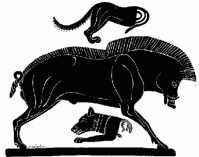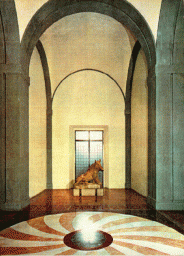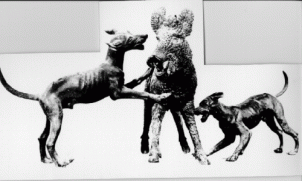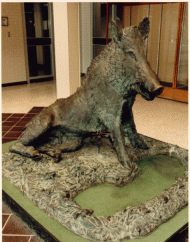Hours
Appointments encouraged.
Monday to Friday
9:00 a.m. to 12:00 p.m.
1:00 p.m. to 4:00 p.m.
View full library hours.
The wild boar was widespread throughout ancient Greece. Its ferociousness, destructiveness, and strength made it a worthy opponent for the hunter and heroes of Greek mythology. Fear of these wild beasts resulted in legends arising to explain the nature and purpose of their being. Boars were often associated with certain gods or as sent by them to punish the human race. Artemis, the goddess of hunting, mountains and forests, is the most closely linked with the wild boar. As a wild and fierce animal, the boar was regarded as a symbol of one side of Artemis' nature, capable of unleashing sudden, violent destruction on humans and property. The Kalydonian boar was regarded as an instrument of her vengeance, sent by Artemis against King Oeneus because he had failed to offer her the first fruits of his harvest. Her sacred buildings were often decorated with images of boars' heads.

Image taken from a Greek vase depicting the Kalydonian Boar. The boar has severed the dog into two parts. Details of the head have been well conceived but its legs and feet more closely resemble those of horses.
Because of their strength, courage, and ferocity, the wild boar symbolized a worthy adversary for the hunter as well. Theseus determined to slay the Krommyon boar to prove his bravery by risking his life in battle against this formidable opponent. The fourth of the labours of Herakles involved the pursuit and capture of the Erymanthian boar. Odysseus managed to overcome his beastly foe but not before its tusks left their mark on his body. Unfortunately, the ferocity of the boar hunted by Adonis led to his death. The Greek farmer or warrior hunted the wild boar to protect crops or for sport. The hunter might dedicate the tusks of the boar, killed in dangerous circumstances, in a sanctuary or mount its tusks upon a battle headdress.
Artists of the Archaic period of Greek art were attracted to the muscular build, pliant skin, bristly mane, and fierce countenance of the wild boar. Its image appeared often on coins, gems, vases, and reliefs.
These depictions of wild boars, taken from Archaic vases, display the artists' interest in their strong build and the decorative possibilities of the mane, tail, and fur. During the Hellenistic period artists concentrated on portraying people and animals naturalistically as shown in these gems. The fierceness of the boar and the dangers of hunting it remain a constant element.

This marble statue of a wild boar (from which UWaterloo's casting was taken) is rendered in a completely naturalistic manner characteristic of the Hellenistic period. It sits in the Uffizi, Florence.
The large, tusked wild boar (cinghiale) was found in abundance in almost every country of the ancient Roman world and particularly so in Italy. Wealthy Roman gentry often established private parks, called vivaria, in which boars were kept. These partially tamed animals were sometimes trained to come running when their keeper, dressed as Orpheus, whose renowned musical ability with the lyre enabled him to charm wild beasts, announced their mealtime. Apparently, these antics gave pleasure and amusement to their owners. The proximity of the boars also allowed owners to serve an exotic meat to guests on special occasions. Another reason for keeping boars in vivaria was for the sport of hunting, primarily for its own sake, and secondarily for provisioning the table in a more exciting manner than direct slaughtering. Wild boars also made appearances at spectacles in Rome, tamed for display or as part of a procession, or wild and battling each other or other animals. Animals in Roman art look back to Greek or Hellenistic models, and it is difficult to detect how far they reflect a genuine Roman sensibility. Nonetheless, images of boars, alone or as part of a hunting scene, have been discovered decorating a wide range of objects.
On this chariot pole the boar is shown as if running, with his forelegs extended. This boar was probably an owner's symbol, perhaps a Roman family badge. Men named Boar often had the boar as an emblem. As the most ferocious beast in the pantheon of the hunt, the boar was an apt symbol of Roman virtue.
Fantasy hunt on a mosaic floor decoration, showing men using a weighted fishing net, from two boats, to catch various land animals. 4th century AD.
The Renaissance signalled a period of rediscovery. Greco Roman statues were greatly admired along with the legends that inspired them. The city of Florence became the intellectual and artistic capital of southern Europe for a century, beginning in the early fifteenth century. It took for its model the ancient Roman republic and its populace were urged to identify themselves with its spirit. In art, a new realism emerged based on the study of humanity and natural forms and coupled with the idealism of Classical forms.
Around 1620 a Florentine sculptor by the name of Pietro Tacca (1577-1640) made a bronze casting from the marble boar, Cinghiale, now in the Uffizi (see the photograph above). Tacca began his career in 1592 when he became an apprentice in the studio of the renowned Renaissance sculptor, Giovanni Bologna. The manufacture and international export of small bronze statues were staple products of the workshop. Here Tacca was trained in the techniques of marble sculpture, bronze sculpture, and bronze casting. His talent and technical skill soon propelled him into the role of Bologna's principal assistant. Upon Bologna's death in 1608, Tacca became Workshop Director and court sculptor. In this capacity, his claim to fame is his equestrian statues of the Grand Duke Ferdinando I of Tuscany, Henry IV of France, and Philip III of Spain. Tacca, as court sculptor, was forced to undertake smaller commissions as well. For the wedding of Prince Cosimo in 1608 he executed eight bronze turtles for the bases of the obelisks in Piazza Santa Maria Novella. Maria de Medici ordered him to create statues and groups of figures in sugar as table decorations for her wedding banquet. Among these statuettes were the labours of Hercules, hunting scenes, and groups of figures such as cupids, centaurs, monsters, animals, and fountains.
Tacca was best known for his technical brilliance and his refining of the casting process. Unfortunately, his fame did not his fortune make as he constantly complained about not getting paid for work completed. In addition, his health suffered. As a master founder he closely supervised every step of the casting process to the point of endangering his physical safety and health for a lifetime. The casting of a bronze sculpture involves the pouring of molten metal. This process could take place any time, but since the dry months of late summer and early fall were preferred for the drying of the core or plaster models and molds, this meant that the casting normally took place in the winter or spring. These were the coldest and dampest seasons in Florence. As well, the Borgo Pinti studio was situated in one of the lowest parts of the city, facing a narrow, dark street and backed upon open fields. Scholars have speculated that Tacca must have been truly miserable as he faced the boiling temperatures of the casting furnace in a cold and humid foundry.
 Tacca's recasting of the Greco-Roman Cinghiale may have been influenced by this piece. The group, which derives from Hellenistic animal sculpture, originally stood between bronze figures of a snake, a deer, and a lion on the semi-circular fountain basin in the middle of a peristyle. Water gushed in to the pool from two sources: a pipe in the boar's mouth and from the mouth of the hound on the right, which is trying to bite the boar's leg. The front paws of the hound on the left were fixed to the side of the boar by rivets. Tails and ears were cast separately.
Tacca's recasting of the Greco-Roman Cinghiale may have been influenced by this piece. The group, which derives from Hellenistic animal sculpture, originally stood between bronze figures of a snake, a deer, and a lion on the semi-circular fountain basin in the middle of a peristyle. Water gushed in to the pool from two sources: a pipe in the boar's mouth and from the mouth of the hound on the right, which is trying to bite the boar's leg. The front paws of the hound on the left were fixed to the side of the boar by rivets. Tails and ears were cast separately.

In 1962, five copies of Tacca's sculpture were cast by the Florence foundry, Fonderia Ferdinando Marinelli. Thanks to the generosity of Dr. Henry Crapo one of these was donated to the University of Waterloo in 1978. The four other copies of the boar are located in Sydney, Australia; California; Florence; and in Butchart Gardens, Victoria, B.C.
Top of page
Research by Michele Laing.
Appointments encouraged.
Monday to Friday
9:00 a.m. to 12:00 p.m.
1:00 p.m. to 4:00 p.m.
View full library hours.
Dana Porter Library, first floor
University of Waterloo Library
Waterloo, Ontario N2L 3G1
519-888-4567 x42619 or x42445
The University of Waterloo acknowledges that much of our work takes place on the traditional territory of the Neutral, Anishinaabeg and Haudenosaunee peoples. Our main campus is situated on the Haldimand Tract, the land granted to the Six Nations that includes six miles on each side of the Grand River. Our active work toward reconciliation takes place across our campuses through research, learning, teaching, and community building, and is co-ordinated within the Office of Indigenous Relations.